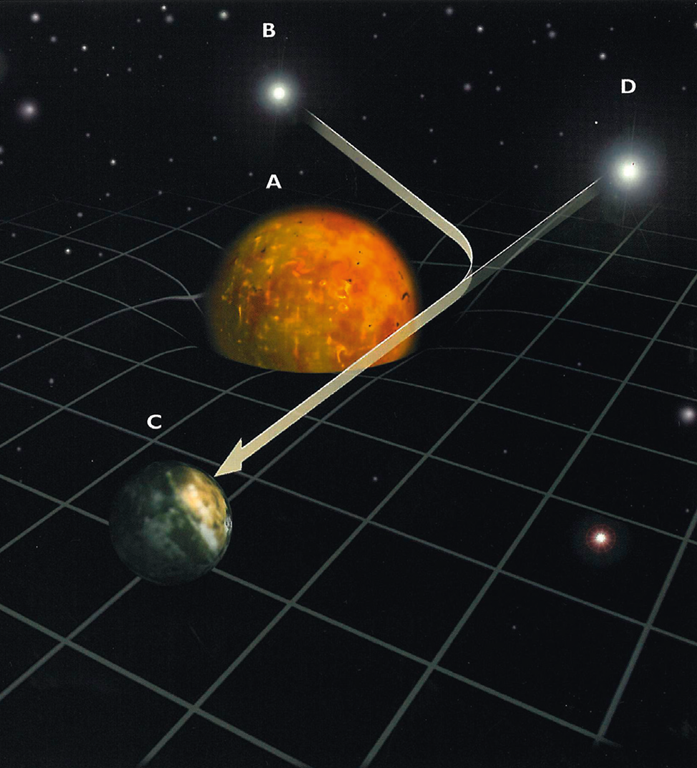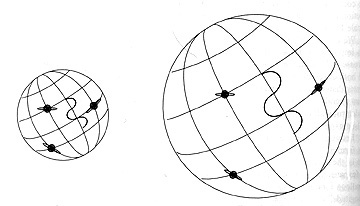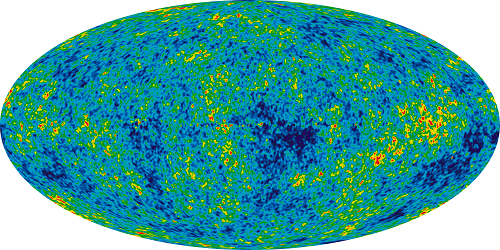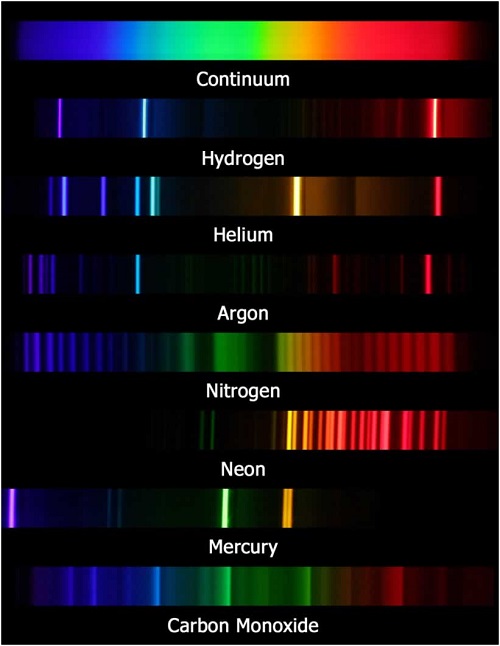|
Expansion of the Universe
The first indication, historically, that the universe had not always been the way people see it now is actually in the Bible. Twelve times God is quoted as saying He stretched out the heavens. Through the years, if anyone paid attention to this idea, it was interpreted to mean, more or less, that the sky was stretched out over the earth. Other than that, there is no indication of any idea that the universe had ever been considered to be anything other than the way we see it.This is the original "steady state" theory. In 1915, Einstein published his papers on General Relativity. The equations he was dealing with were gravitational equations, but they were also relating to time in the shape of space. The idea here was that a massive object would bend space around it, something like this:
In the above illustration, "A" is a massive object which is distorting space/time around it, as shown by the grid lines. In the theory of General Relativity, the path of a light ray will also follow the bending of space created by the massive object, so that an object which is actually at position "B" is seen by someone on "C" as being at position "D." The theory of General Relativity allowed several options regarding the behavior of the universe through time. All the options, however, required either the expansion or contraction of the universe. However, because Einstein himself believed in the steady state universe, he arbitrarily put an extra term in his equations to allow General Relativity to support a steady state model. The term he inserted is called "the cosmological constant." This constant could be positive or negative depending on the desired result. The Red Shift implication By the time Edwin Hubble's work regarding the red shift had become known in the 1920's, Einstein's theory of relativity had gained wide acceptance. Hubble's work, however, was taken as meaning the universe was expanding. Many scientists realized that this expansion was exactly what Einstein's equations showed without the addition of the cosmological constant. Einstein himself later admitted that the addition of the cosmological constant was his greatest mistake. Einstein came to the conclusion that, without the cosmological constant, what was happening was that galaxies were moving away from each other through a static space/time continuum, something like marbles being rolled across a floor in all directions. In this model, the only way the red shifting of distant light could be explained was via the Doppler Effect. This effect is explained very well in the Physics Classroom in terms of sound. With sound, the shorter the distance between the waves, the higher the pitch. Light does something similar: if an object which emits light is moving away from you, the light waves will be 'stretched' so that there is a greater distance between peaks. It is the distance between the peaks which determines the color -- the longer the wavelengths, the more the color shifts to the red end of the spectrum. It is for this reason that the red shift, in Einstein's eyes and in the eyes of some in astrophysics today, indicates a continuing universal expansion. This is often also taught in textbooks. Others, such as Friedmann and Lemaitre, looked at Einstein's equations and thought they could be modified in certain ways. They also eliminated the cosmological constant. Their concept of the expansion of the universe was different from Einstein's, however. They thought the entire fabric of space/time was expanding, carrying the galaxies with it. The picture that would help explain this concept is that of a balloon with black dots being blown up. The dots move progressively away from each other as the balloon get bigger.
The concept, as shown in the above illustration, indicates that not only galaxies would move away from each other, but that light waves themselves, as shown by the wavy line, would be expanded. This model also allowed an explanation for the red shifting of light through space, as the longer the light was traveling, the more the waves were stretched and thus the redder they would become. This model is also taught in textbooks today. If someone points out a problem with Einstein's model, there is a switch to this one. If someone points out a problem in this model, there is a switch to Einstein's. The result with both models was that if the universe was currently expanding, it had to have been expanded from something smaller. But how small? And why? The conclusion was the entire universe had expanded out from a point called a singularity. This singularity was incredibly dense and hot -- they considered it to be about ten miles across and billions of degrees. From the initial moment it somehow appeared, expansion started. Originally, at Gamow's suggestion, this incredibly dense matter was thought to be neutrons, which then decayed into protons and electrons. As it expanded, the soup of protons and electrons quickly formed hydrogen and some helium. Up until the 1940's, they thought all the elements could be built up this way, out of the initial soup. They found a serious difficulty with this, however, when they discovered there is no element with a mass of 5. This means that the process of adding one proton or neutron at a time to build up the various elements was in doubt. They could get helium and a bit of lithium 7, but in order to get anything else, they found they needed to have in existence one other somewhat heavier element to spark the combining. This concept of a needed other element was called "Wigner's Bridge over the Mass 5 crevice." They tried carbon, but for a variety of reasons, carbon did not work. * At this time, then, an expansion had come to be agreed upon by all theorists, primarily due to the red shift data. But the formation of elements beyond hydrogen and helium (and a bit of lithium) remained a puzzle. A full explanation of the Big Bang theory as it exists today is done quite well on Wikipedia. The moniker "Big Bang" was an insulting one given to this model by Fred Hoyle, a renowned physicist and astronomer, in 1949. The name stuck. The problem of the formation of elements remained a persistent problem. In 1954, it was Fred Hoyle himself who formulated a theory to solve that problem in terms of his favored steady state model. It was he, with his nucleosynthesis model, who presented the concept -- based on physics and mathematics -- that the heavier elements had built up inside stars, which then exploded and sent these elements through space. The Big Bang folk realized that here was the answer to their problem, so they co-opted the theory. This solution, however, does not work. The problem lies primarily with the formation of the first stars. The concept that gas and dust contracted gravitationally and then formed a star in which the elements could be made runs into a problem with the contraction itself. As any gas, hydrogen included, contracts, it heats up. This causes it to expand. In order to get around the heat problem, some have proposed that carbon monoxide or similar could radiate the heat out in the infrared, and so avoid the expansion. And there is the problem: where did that carbon monoxide come from if there was only hydrogen and helium in the initial universe? As the Wikipedia article linked above states, there are a number of problems still associated with the Big Bang model which various theorists are trying to solve. All of them, however, are trying to solve the problems based on the assumption that gravity is the primary force which was responsible for the formation of objects in the universe. This is one of the reasons both dark energy and dark matter have had to be presumed, regardless of lack of physical evidence of either. The currently widely accepted answer to many of the Big Bang problems is in the inflationary model. This model was proposed by Alan Guth in 1981. This model proposes that there was an initial period of extremely rapid expansion at the beginning. It is this which is referred to as "inflation." After this episode concluded, a more general expansion continued. This model helped explain the uniformity of space as well as the uniformity of the laws of physics, but it did not help explain the formation of the elements. By the late 1990's other physicists were looking at other ways to solve the Big Bang problems. For instance, Albrecht and Magueijo in Physics Review D proposed an initial very rapid speed of light, which would then allow "communication" across the universe, also solving the uniformity problem. Their proposal was that the speed of light would have started out at 1060 times its current speed. Other physicists have looked at both the possible change in the speed of light as well as a possible change in other atomic constants as a way of overcoming the problem. One major problem remained: why did the universe expand? Interestingly, Einstein's cosmological constant has been invoked for this. The cosmological constant is supposed to be the opposite of gravity, pushing things apart. This has now become known as "dark energy." The problem with that proposal is that we should be able to see its effect in our outer solar system, but that effect is not there. What we have found is that the required value of the cosmological constant, in order to expand the universe, is 120 orders of magnitude greater than what observation allows. The Cosmic Microwave Background Radiation (the CMBR) Despite the problems with the Big Bang model, the evidence for some kind of expansion, at least in the early universe, became definitive with the discovery of the CMBR. In the 1940's and 1950's, Gamow and several others, working with the idea of cosmological expansion from an initial hot, dense point, figured there must be some evidence of that "out there" in the form of very low temperature background radiation. He estimated the temperature in 1946, to be about 50 Kelvin. In 1948, the estimation was changed to 5 Kelvin. The low temperature would be because of the cooling of the initial mass as it spread out. This proposal lay dormant until 1964, when Penzias and Wilson were using a horn antenna to gather radio and microwave data from space. There was a persistent noise which they could not get rid of in their data (they first suspected it might have come from pigeon droppings and cleaned the entire apparatus thoroughly). Regardless of what they did, that noise was still coming in uniformly from all parts of the sky. As this noise was analyzed, they realized it had the characteristics of a body radiating at a temperature of 2.73 degrees Kelvin (this is same as radiation from a black body at that temperature. An article on Black Body Radiation explains this very well.). It was then realized that this was the "echo" of the Big Bang which had been predicted earlier. A lot of time and effort has been spent in analyzing this radiation in detail. It is smooth to one part in ten thousand, but smaller than that it does break up into areas of slight heat differences. What was then found was that there appeared to be something like a "fog bank" at the outer edges of the universe from which this radiation was coming. The fog bank was in all directions and it was evident light was not penetrating it. As the data was examined in detail, the picture has emerged of the initial universe existing as a very dense plasma. This plasma was cooled from its initially hot state by the expansion. In this plasma light could not escape because it was being bounced backwards and forwards by the particles of plasma in the same way as headlight from a car cannot penetrate a dense water fog.
As the plasma cooled, it eventually reached a temperature where atoms could form -- the initial hydrogen. At that stage, which is called "decoupling" when matter and radiation separate, light could finally shine out from the fog. So when we look back at the edges of the universe, and thus look back in time, what we are seeing is something like what you see looking back after you emerge from a fog bank.
An illustration of what is seen in space is something like this:
The evidence presented by the Cosmic Microwave Background Radiation strongly supports an initial expansion of the universe. There are those who try to argue against this evidence by claiming that what is being measured is actually coming from our own oceans or our own galaxy. But this is negated by the fact that the signals are coming from every direction whether on earth or measured by spacecraft. Hydrogen Clouds Spread more or less uniformly throughout space are clouds of hydrogen gas. When light passes through them, the gas will absorb a specific wavelength of light, leaving a dark line on the spectrum. To understand what this means, it is important to understand that every element can produce light. Light is produced when an electron is forced out of position and then snaps back into its correct position relative to its nucleus. The energy released as it snaps back is released as a photon of light. We can identify elements in space because every element, when analyzed by a spectroscoope, produces a unique series of light and dark lines, a sort of individual "bar code" when it releases a photon of light.
The areas of the spectrum where light is emitted are the colored lines and areas. The areas of the spectrum where light is absorbed are the dark lines and areas. There are times when we see a certain 'bar code' shifted slightly to the red or blue end of the spectrum, but the pattern for any individual element will remain the same and so identifiable. As mentioned in the section on the Red Shift in the Plasma Model page, "the amount of red shift is an excellent indicator of distance, but it may not be an indicator of motion." Light emitted from a distant galaxy will exhibit the full range of colors on a spectrum. When this light passes through a hydrogen cloud, the light from all elements except hydrogen remains unaffected. However the light from hydrogen is partially absorbed. That bit of absorption leaves a dark line where a light line should be on the hydrogen 'bar code.' But that line is left where the bright line should be at the red shift distance at which the cloud is. The next closer cloud will be at a slightly lower red shift distance and so any hydrogen light absorbed by that cloud at that distance will leave its signature dark line at a slightly bluer end of the spectrum. The number of these dark lines, replacing the bright lines we would expect to see at these various distances, not only shows us how many clouds this light has passed through, but at what distances those hydrogen clouds are. This collection of dark lines from hydrogen on the contiuous spectrum is called the Lyman Alpha forest, after the man the did some of the initial work with light spectra. So far, what this forest has shown us is only that there are quasars at very distant reaches of our universe. When we look at hydrogen clouds in our own super cluster of galaxies, we see they are quite evenly distributed. Even as we go out further, they are evenly distributed. But as we continue searching the distances, the groups of dark lines in the Lyman Alpha forests at the farther ends of the red shifts indicate that the clouds are closer at those great distances. We know that distance indicates time when we look out. The farther we look out, the further back in time we are looking. So what we are seeing is that, nearer to the beginning of the universe the hydrogen clouds which are so evenly distributed today were much closer to each other then. This is another indication that the universe has expanded. In conclusion, we have strong evidence from the red shift, the CMBR, and the Lyman Alpha forest from hydrogen clouds that the universe expanded initially. This is in strong agreement with the Bible's claim that God stretched out the heavens, which is repeated in various sections, twelve times. Now, one question remains: Is the Universe Still Expanding? Because the red shift values rise dramatically as we reach the frontiers of the cosmos, the claim is made that not only is the universe still expanding, but it is expanding at close to the speed of light. This claim is made on the basis of the red shift being either a result of the Doppler Effect or of the fabric of space itself expanding. While there is not problem with the concept that high red shifts indicate distances, there are a number of problems connected to the idea that red shifts are connected with current expansion. 1. If the red shift were a result of motion (the Doppler Effect), then the galaxies at the frontiers of the cosmos, which are presumed in this case to be traveling close to the speed of light, would be disrupting. We do not see that happening. These distant galaxies are just as cohesive as galaxies in our own Local Group. 2. If the red shift were a result of the fabric of space expanding, and stretching the wavelengths of light iin transit, the width of the spectral lines would also be stretched out, showing up as wide and fuzzy on spectrographs. But they do not. They are clear and sharp, regardless of distance. 3. In either of the above theories, the measurements of the red shift with increasing distances should be a smooth function, showing continuous changes the farther out we look. This is not what has been found. In the 1970's, astronomer William Tifft noted that the measurements he was taking of red shifts were not progressing smoothly as expected, but were clumped. This became referred to as 'quantized red shifts.' His work was generally ignored and/or ridiculed as being the result of observer error. In 1990 and 1992, astronomers Guthrie and Napier, determined to disprove Tifft, examined over a hundred more galaxies for red shifts. They ended up finding exactly what Tifft had found -- the measurements were going in jumps. In 1996, a study of the galaxy cluster Abell 85 by Durrett et al revealed bands of red shift going through the cluster itself and beyond. This is what Tifft had seen happening in the Coma Cluster. In May, 2003, Morley Bell presented evidence that the galaxy clusters studied by the Hubble Key Project contain quantized, intrinsic red shifts, like those reported by Tifft. In September, 2006, it was found that the red shift distribution of 46,400 quasars in the Sloan Digital Sky Survey Quasar Catalogue showed six quantization peaks. In 2010, it was noted that if quasar clusters are examined, and the central red shift of that cluster is taken, then systematic red shift differences occur. The implications were enormous, and, to this day, still largely ridiculed and/or ignored. But imagine a car accellerating along a freeway. What we actually see is the speed smoothly increasing. We do not expect to see it go from 45 miles per hour to 50 miles per hour without any intervening speeds of 46, 47, 48, and 49 miles per hour. That kind of jump is what is being seen with the red shifts, however. So while they definitely indicate distances, there is some strong doubt about their cause being due to motion. One of the things Tifft had noted was that the red shift jump goes through the middle of some galaxies. This would be like one half of a car moving at one speed and the other half moving at another speed. This quantization invalidates both of the standard models mentioned in numbers 1 and 2 above. If the red shift is to be interpreted as ;current expansion of the universe, then the universe is expanding in jumps. That is not possible. But because the red shift is the prime example of universal expansion, in agreement with Einstein's and Friedmann's equations, it is vigorously defended. One of the defenses is to refer to something called "periodicity" or "clustering" of objects to explain the apparent quantization. But quantization of red shifts is entirely different from both of these. Evidence from close to our own galaxy indicates that neither clustering nor periodicity has anything to do with red shift jumps. One point should be noted here. This observation of red shift 'shells' as we look out from Earth has been used by some creationists and others to claim this proves the earth, or our galaxy, is the center of the entire universe. This is a fallacy based on a misunderstanding of what is happening. Let us use a picture: If I am standing in the center of a town, I see the building all aroud me, block by block. This does not mean the town is the center of the county, let alone the state or nation. What I see is a result of where I am standing. It is the same way with the red shift 'shells.' No matter where you might stand in the entire universe, where you are at that moment would be "here and now." From that point, whereever it might be, you would look out into the past -- the "then and there." There would be no red shift where you were, because that is your "now." But you would see the red shift in shells as you look back to "then." So anyplace could seem like the center of the universe to an observer who considered the existence of the red shift shells to be evidence of a center. Red shift shells simply indicate a distance from a given point -- wherever you are. If red shift is not due to motion, what causes it? That has been discussed in a number of papers on this website. The shortest explanation is in the Plasma Model paper. A more detailed, but still lay-friendly explanation is in "Is the Universe Static or Expanding." The technical papers can be found in the Research section. 4. There is something about hydrogen clouds which shows the expansion of the universe is no longer occurring. There is clear evidence that there was an initial expansion as we look at their proximity to each other at the far distant reaches of the universe. However, from a red shift (referred to as "z" in graphs) of 1.6 in to where we are today, there is no change in their distribution. This means the universe is not expanding now, or we would see that change much closer to the "here and now" and not just the "then and there." * In the 1990's, Professor Ed Boudreaux suggested oxygen as the other element. He was able to show that the presence of oxygen, with hydrogen, in a hot plasma, would allow the production of all the elements in their known quantities in less than an hour. It should be remembered that water is H20 -- two hydrogen for every oxygen. A water plasma would have electrons detatched, but it would still have the nuclei of hydrogen and oxygen in a ratio of 2:1, although they also, would not yet be connected. Interestingly, the Bible states that the heavens were involved with water by the very name the Hebrews used for them -- shamayim. "Mayim" is the word for water. Implications from this can be read in the Genesis Bible Study.
|





